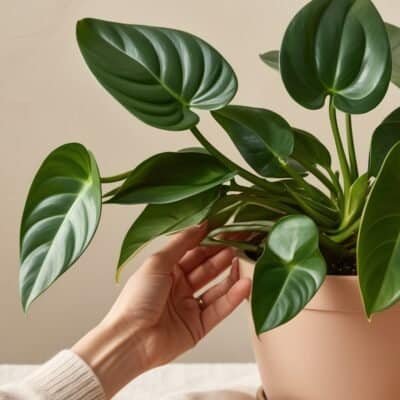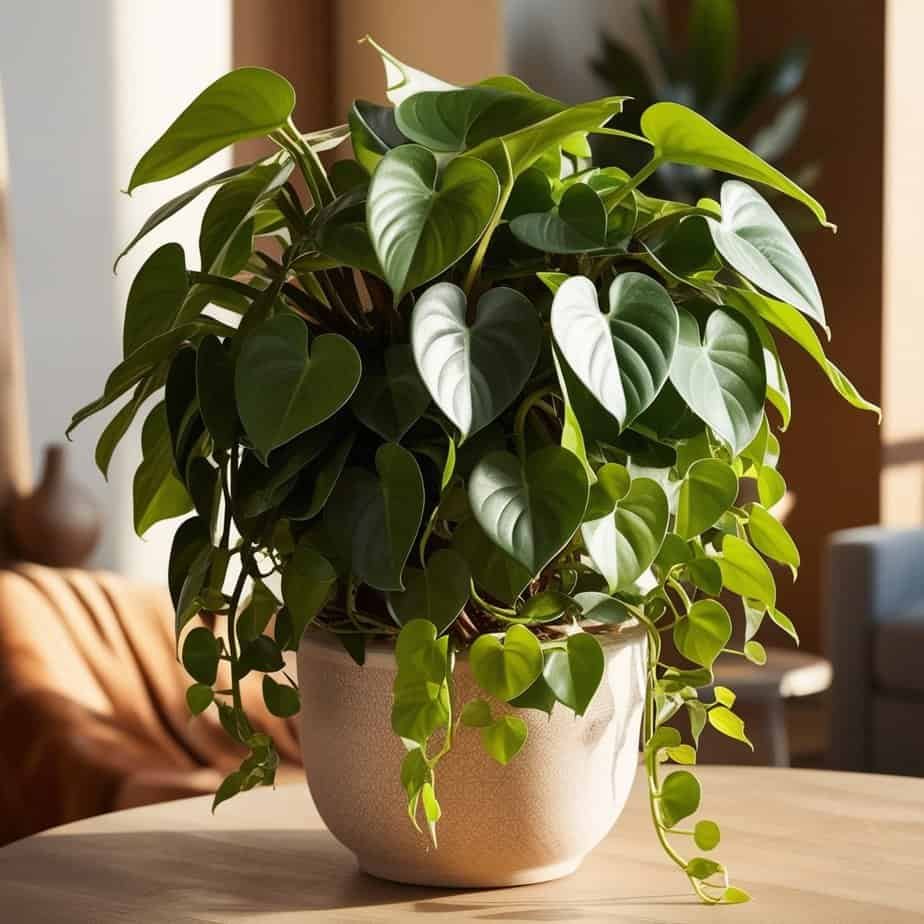The Heartleaf Philodendron is easy to love with its heart-shaped leaves. This tropical houseplant brings lush green foliage to any space. Both new and experienced plant owners find success with the Heartleaf. It thrives in various indoor settings with minimal care. The sweetheart plant earns its name by flourishing with just the right amount of sunlight, water, and room to grow. Keep reading to discover how to make your Heartleaf Philodendron thrive with simple techniques.
Key Takeaway
- The Heartleaf Philodendron flourishes with low-maintenance care across different light environments.
- Proper watering and humidity help this plant stay healthy.
- Keep it out of reach from pets and kids since certain parts are moderately poisonous.
What is a Heartleaf Philodendron?
The Heartleaf Philodendron, also called Philodendron hederaceum, hails from Central and South America. Lovers of houseplants appreciate its attractive heart-shaped leaves, reaching up to four inches long [1]. This tropical plant adds greenery to any space without much work.
The Heartleaf offers perks beyond its looks. It purifies air by filtering toxins, leaving rooms feeling fresh.
New and experienced plant parents find success with the Heartleaf. It does well in different indoor settings, making it a flexible pick. Between its full foliage and low demands, this sweetheart plant brightens living spaces with little effort.
Care Requirements
Light
Heartleaf Philodendrons favor medium to bright indirect light. They adapt to low light but may become leggy with too little, leaving large gaps between leaves [2].
For an attractive plant, position it where filtered sunlight reaches. A window with sheer curtains provides sufficient bright light indirectly. This satisfies the plant without risk of sunburn from direct rays.
If leaves yellow or the plant appears weak, it may not get enough light. Crispy leaves could mean too much sun. Observe your Heartleaf to balance its needs, allowing it to flourish and enhance its space with vibrant foliage.
Watering
Watering plays a key role in a Heartleaf Philodendron’s health. The best approach is watering when the top inch of soil dries out, usually every one to two weeks.
Take care not to overwater, which can cause deadly root rot by saturating the soil. Use a pot with drainage holes to allow excess water to drain, keeping roots happy.
Yellowing leaves might indicate overwatering while wilted leaves could mean thirst. Always check the soil before watering to hit the right balance. With proper moisture care, your Heartleaf Philodendron will thrive, retaining vibrant foliage.
Humidity
While Heartleaf Philodendrons can tolerate lower humidity, they truly thrive when levels reach around 40% or more. The air should feel slightly moist for optimal plant satisfaction.
A humidifier provides an easy solution, infusing moisture into the air to keep your Heartleaf content. Alternatively, set a tray of water near the plant so evaporation boosts the surrounding humidity.
Grouping plants also helps – their proximity generates a mini humid environment for all to enjoy. Maintaining the proper humidity allows your Heartleaf Philodendron to flourish with lush foliage, beautifully enhancing any space.
Soil
Proper soil composition matters for Heartleaf Philodendron well-being. This plant needs aeration at root-level, satisfied by ready-made houseplant mixes. Alternatively, blend potting soil with perlite and orchid bark. This custom mix prevents issues like root rot by incorporating airflow and drainage.
When upgrading pots, size up just enough to accommodate future root growth. As always, check the soil moisture before watering to avoid oversaturation. With the right well-draining potting medium, your Heartleaf Philodendron will flourish with striking foliage.
Growth Characteristics
Heartleaf Philodendrons flourish rapidly when happy. Given ideal conditions, they’ll trail impressively up to 10 feet long. This makes them ideal for cascading from hanging planters or shelves in a lush display.
Upon unfurling, fresh leaves showcase a lovely bronze hue. As they mature, the leaves deepen to a rich green – nature’s subtle color shift adds charm.
Beyond beauty, this plant benefits the atmosphere. It purifies indoor air by filtering toxins. In turn, cleaner air uplifts any home. With striking foliage and air-improving powers, the Heartleaf Philodendron infuses life and freshness wherever it grows.
Toxicity
It’s important to note that while Heartleaf Philodendrons look lovely, their foliage presents some toxicity risks. Ingesting parts of this plant can irritate and burn the mouth or throat.
For homes with children or pets, elevated displays or closed-off rooms provide barriers. This allows enjoying the plant’s aesthetic without concern for accidental contact.
Always wash hands after touching leaves, as contact alone could theoretically cause irritation. With minor precautions like safe placement and cleanliness, the entire family can appreciate this tropical beauty safely.
How to Propagate
Propagating Heartleaf Philodendrons through stem cuttings proves simple. Snip a healthy stem sporting several leaves.
Insert the cutting directly into soil, buried an inch deep, or place it in water with the cut end submerged and foliage above. Then set in warm, humid conditions like under a plastic bag or humidity dome to spur rapid root growth.
Within weeks, new roots should emerge. This cost-effective technique allows expanding one’s plant collection or sharing with others. With minimal effort, more of these tropical beauties can brighten living spaces through DIY propagation.
Common Pests
Heartleaf Philodendrons may occasionally face common houseplant pests like spider mites, mealybugs and aphids. Check leaves regularly for tiny webs, white cottony spots or small green insects.
If discovered, don’t stress. Pests respond well to insecticidal soap or neem oil – environmentally-friendly treatments applied top and bottom on affected leaves.
Maintaining good airflow also deters pests by preventing stagnant conditions they prefer. Position your Heartleaf where it can benefit from ample fresh air circulation. With regular inspections and quick action when needed, your plant will remain vibrant and thriving.
How Fast Does it Grow?
Heartleaf Philodendrons flourish rapidly during spring and summer, their peak growing seasons. With optimum care, you may notice sizeable growth within weeks.
When content, they achieve impressively long vines. This makes them ideal for cascading elegantly from hanging planters or plant stands. Their climbing habit also allows enriching vertical spaces with greenery.
To spur quick expansion, position the plant for bright, diffused sunlight and water consistently to maintain moist soil. Proper hydration and lighting will energize the Heartleaf to spread prolifically. A bit of TLC rewards with astonishingly fast transformation and an abundance of lush foliage filling out your indoor jungle.
What Type of Soil is Best?
A well-draining soil provides optimal conditions for Heartleaf Philodendron roots. Retaining excess moisture risks harming the plant through root rot.
Potting mixes incorporating perlite or orchid bark address this concern. Perlite adds air pockets allowing water to drain freely from the soil. Orchid bark also improves texture and drainage. Together they keep roots sufficiently dry while nourished.
For repotting, choose a commercial houseplant blend or craft your own by mixing potting soil with perlite and orchid bark. This customized soil ensures your Heartleaf thrives with healthy roots to proudly showcase its stunning foliage for seasons to come. Proper drainage lays the groundwork for vigorous growth.
How to Know if Your Plant is Healthy

A thriving Heartleaf Philodendron displays vibrant green foliage – leaves should feel firm without spots or discoloration. Wilted leaves potentially reveal overwatering stress from soggy roots lacking air. Yellowing could mean insufficient light is reaching the plant.
Regular inspections allow catching potential problems in early stages. Check closely for any deviations in leaf or stem appearance. Identifying issues promptly enables corrective steps to aid recovery. With some attentiveness, your Heartleaf Philodendron will continue thriving indoors, proudly showing off healthy greenery for many seasons to come. Adjusting care as leaves indicate allows this tropical beauty prospering for years of enjoyment.
FAQ
How do I care for a heartleaf philodendron plant?
Heartleaf philodendron plants thrive in indirect light or bright light, avoiding direct sunlight. Keep the soil moist but not waterlogged. Water with tepid water when the top inch of soil feels dry. These plants prefer warm temperatures and high humidity. Feed with a balanced fertilizer during the growing season. Watch for pests like spider mites. Prune regularly to maintain a bushier plant. As part of the Philodendron Plants family, they’re relatively easy to care for, making them ideal for new plant parents.
What light conditions do Heart Leaf Philodendrons need?
Heart Leaf Philodendrons prefer indirect sunlight or bright light. They can tolerate lower light conditions, but growth may slow. Avoid exposing them to direct sunlight, which can scorch the leaves. If natural light is limited, you can use a grow light to supplement. These adaptable plants make an ideal office plant, thriving under fluorescent lights. Their ability to grow in various light conditions makes them popular among plant enthusiasts and a great choice for indoor spaces.
How often should I water my heartleaf philodendron plant?
Water your heartleaf philodendron when the top inch of soil feels dry. Use tepid water or room temperature water, avoiding cold water which can shock the roots. These plants prefer consistently moist soil but are susceptible to root rot if overwatered. Adjust your watering schedule based on factors like temperature, humidity, and light exposure. During winter, reduce watering frequency. Pay attention to leaf curves and yellowing leaves, which can indicate watering issues. Proper watering is key to maintaining healthier plants.
Are Heart-Leaf Plants safe for pets and children?
Heart-Leaf Plants, also known as heartleaf philodendron, are toxic if ingested. They’re listed on the ASPCA Toxic Plant List. The University of Florida also classifies them as poisonous garden plants. While they’re popular as air purifying plants and clean air plants, keep them out of reach of pets and children. If you’re concerned about toxicity, consider pet-safe alternatives like some succulents. Always research plant care topics and consult experts when choosing house plants for homes with pets or young children.
How can I propagate my heartleaf philodendron plant?
Propagating a heartleaf philodendron is easy, making it a fun plant project for any generation of plant parents. Cut a stem with at least one leaf node, ensuring each cutting has 2-3 leaves. Place the cutting in water or moist soil. Roots typically develop within a few weeks. Once rooted, plant in a pot with well-draining soil. This method works for many soft-stemmed plants in the Philodendron family. Propagation is a great way to create a fuller plant or share with other plant people.
What’s the difference between a heartleaf philodendron and a pothos plant?
While heartleaf philodendron and pothos plants look similar, they’re different species. Heartleaf philodendrons (Philodendron hederaceum) have heart-shaped leaves and belong to the Philodendron genus. Pothos (Epipremnum aureum) have larger, sometimes variegated leaves. Both are vining plants native to Central America and make popular houseplants. They have similar care requirements, preferring indirect light and moist soil. However, pothos are generally more tolerant of neglect. Both are favored by plant enthusiasts for their easy care and air-purifying qualities.
Conclusion
The Heartleaf Philodendron is a versatile houseplant that thrives with minimal care. Both new and seasoned plant owners can enjoy its beauty. Only light, water, and moderate humidity are needed for healthy growth. It adapts to various conditions indoors, resiliently displaying lush foliage. For a rewarding plant that uplifts any environment with its vibrant leaves, the Heartleaf Philodendron proves a reliable choice.
References
- https://www.thespruce.com/heartleaf-philodendron-guide-5181702
- https://www.guide-to-houseplants.com/heartleaf-philodendron.html
Related Articles
- https://knowngarden.com/house-plants-philodendron/
- https://knowngarden.com/a-philodendron/
- https://knowngarden.com/do-philodendron-like-to-be-root-bound/

